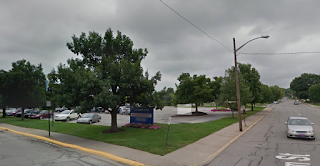 |
| Much of the neighborhood and historic south wings have been lost |
 |
| How much of the neighborhood appears today |
We've seen this with St. Elizabeth's hospital and St. Mary's catholic church. Lafayette being an older, crowded river city built for the pre-automobile age often finds itself in a fit of demolitions in order to make room for auto-era facilities (and the auto-related needs of patients). These large hospital complexes require parking, office space, hospital beds, research wings, maintenance buildings, etc., etc. This in and of itself is not a surprise and is to be expected, however, the route that such large institutions have taken in this city to address these particular needs has been one of destruction. The neighborhood around St. Elizabeth's is a prime example. With St. Mary's towering steeple in sight, making evident the close proximity of our beloved downtown, one feels as if they are driving through an outskirt of Lafayette. So devastated is the built environment that one would hardly know the neighborhood is over 150 years old. The issue further is that the new buildings and facilities replacing the old neighborhood did not accommodate the pedestrian nor did they respect the urban fabric of that neighborhood (an issue repeated in the new nearby CVS). Often the new structures were built surrounded by parking like a suburban facility. But what can be done? Community control over historic preservation in this historic (albeit troubled) neighborhood is already severely lacking and shows no signs of emerging anytime soon. As Mary Hufford remarks in Conserving Culture: A New Discourse on Heritage, often poor historic neighborhoods are treated as slums and burdens in desperate need of removal (Hufford, pg. 69). With this, there is little opposition to any expansion of an institution like St. Elizabeth's.
 |
| From this |
 |
| To this |
 |
| Architectural detail on home hospital pre-remodel |
It isn't only with neighborhoods. Often historic hospitals themselves are pulled down in the name of progress, robbing our city of important historical landmarks. A great example is the old home hospital. Home hospital was originally built in the early 20th century as a brick colonial-revival. It was an important landmark that anchored the entrance to Columbia Park. However, following an insensitive remodel in the 90's, the building lost most of its historic character. With this loss of historic detail, there was little protest when the structure came down in 2013, leaving behind space for another, suburban and auto-oriented project in its place. While this development has offered many wonderful services to the community, one wonders if restoring the old hospital could not provide the same benefits?
However, with all this gloom it seems as if the demolition of historic buildings and neighborhoods by major institutions is inevitable. Yet, if we look at a particular institution in our community we see that this is not inevitable. Ivy Tech Community College has re purposed the old Ross Sanitarium into their main offices. The Sanitarium, built around the same time as the original home hospital, is a beautiful example of colonial-revival architecture. Unlike its sister, it was not reduced to ruin after a botched face lift. Instead, the Ross Sanitarium has found new purpose in our growing city. The question is, how do we as a community work with these institutions to preserve our neighborhoods and landmarks, but also provide for the needs of a growing institution?
 |
| Ross Sanitarium has found new life |

